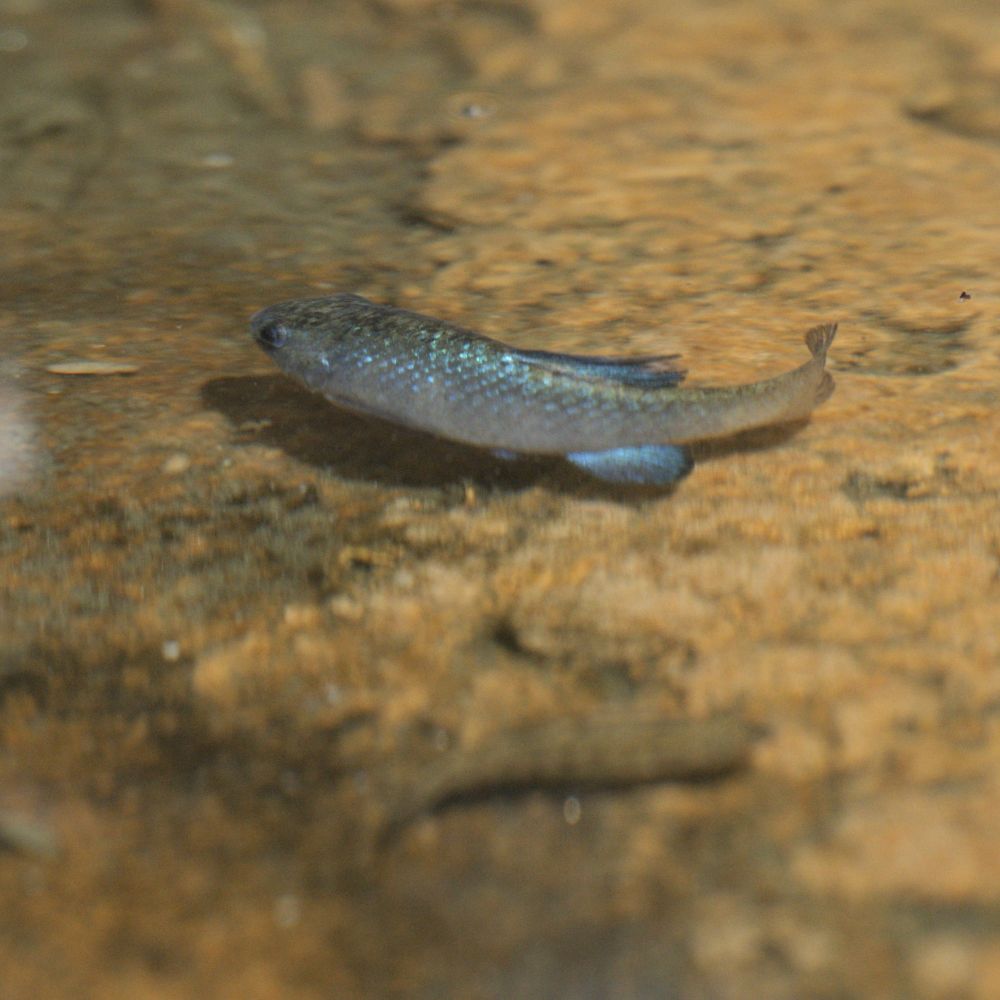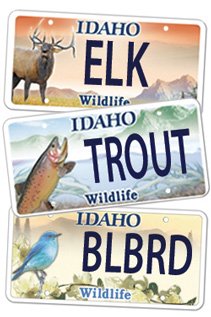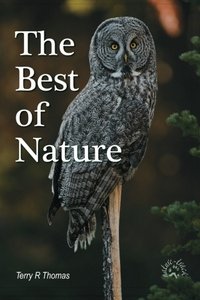Island Habitats

©Terry R. Thomas/www.nature-track.com
This 1.5-inch-long fish, the Quitobaquito pupfish, lives in an island habitat called Quitobaquito pond and its species will likely live or die with what happens to its island.
They are called sky islands. Tall mountains surrounded by a “sea” of desert , yet almost literally, not a drop of water to be found. Across Arizona, New Mexico, and northern Mexico, there are about 55 of them, isolated mountain ranges with completely different habitats than the land surrounding them.
Island habitat, while named after the traditional islands of the oceans, does not refer only to literal islands surrounded by water. Island habitat is defined as, “any area of habitat suitable for a specific ecosystem, surrounded by an expanse of unsuitable habitat.” Unsuitable habitat means that the animals and plants on the “island” could not survive there, just like a coconut tree could not grow in the ocean.
We camped recently in an Arizona sky island for a week. Just a mile up a canyon from the desert floor, we were in a considerably different area, one that attracted migrating warblers and other birds, supported white-tailed deer, black bears, cougars, coatimundis and a host of other animals that are essentially absent on the desert floor. The flora included sycamores, oaks, junipers, cottonwoods, maples, and up higher, ponderosa pine. The top of the canyon is over 5,000 feet higher than the valley floor. The valley floor was dominated by mesquite shrubs and grassland, and further north, by saguaro cacti. And the temperature was about 10 degrees cooler in the canyon than on the valley floor. The desert was clearly an uncrossable barrier for most mountain species and the species on the mountains widely different than the surrounding desert. The mountain range is truly an island and distinctly different.
Island habitats can occur anywhere, and can even be created by man. Years ago, I was on a committee tasked with evaluating land purchases for Idaho Department of Fish and Game. At one point, a property was proposed for disposal so another property could be acquired. The rationale was that because all the surrounding country around this north Idaho property had been logged, this final unlogged section was of little value. I argued (unsuccessfully) that this little “island” of habitat, created by human activity, was all the more valuable because it was the last remaining intact segment of its kind in the entire area and a final refuge for several species.
Island habitats can include entire tall mountain ranges such as the sky islands, the tops of other high mountains, lakes—for aquatic species the water is the habitat and the land is the desert, springs, or even woodlands surrounded by prairie (or vice versa) or agriculture. It is not the type of habitat that makes it an island, it is the isolation. What they share with traditional islands surrounded by water are ecological principles directly related to being isolated.
And here is where island habitat becomes interesting. Because of the isolation, islands have a high degree of endemism, or native species unique to that location. For instance, right on the border with Mexico, near Lukeville, Arizona and within Organ Pipe Cactus National Monument, there is a small spring and pond called Quitobaquito which is surrounded by desert. This pond is the only free fresh water for miles. More, it is home (along with several other springs in the general area, but south of the border) to two species that exist nowhere else in the world: the Quitobaquito pupfish and the Sonoyta mud turtle. Quitobaquito pond is an island habitat with no connection to other habitats. These two species will largely exist or go extinct depending on what happens here.
More on island habitats next time.
Help Idaho Wildlife
When we traveled across the state in October 2017, we visited most of the Idaho Department of Fish and Game wildlife management areas. Most of the vehicles we saw using the wildlife management areas did not have wildlife plates. Buying wildlife plates is a great way for non-hunters and hunters alike to support wildlife-based recreation like birding.
C'mon folks, let's help Idaho's wildlife by proudly buying and displaying a wildlife license plate on each of our vehicles!
See below for information on Idaho plates. Most states have wildlife plates so if you live outside Idaho, check with your state's wildlife department or vehicle licensing division for availability of state wildlife plates where you live.
And tell them that you heard about it from Nature-track.com!

Wildlife License Plates
Great news! as of 2024, there are three NEW designs for license plates. They still are bluebird, cutthroat trout and elk, but they are beautiful.
Idaho Wildlife license plates provide essential funding that benefits the great diversity of native plants and wildlife that are not hunted, fished or trapped—over 10,000 species or 98% of Idaho’s species diversity. Game species that share the same habitats (such as elk, deer, antelope, sage-grouse, salmon, trout) also benefit from these specialty plates.
No state tax dollars are provided for wildlife diversity, conservation education and recreation programs. Neither are any revenues from the sale of hunting or fishing licenses spent on nongame species. Instead, these species depend on direct donations, federal grants, fundraising initiatives—and the Idaho Wildlife license plates.
Both my vehicles have Bluebird Plates. I prefer the bluebird because the nongame program gets 70 percent of the money from bluebird plates, but only 60 percent of the money from elk and trout plates - 10 percent of the money from elk plates supports wildlife disease monitoring and testing programs (to benefit the livestock industry) and 10 percent from cutthroat plates supports non-motorized boat access.
Incidentally, in 2014, the Idaho Legislature denied the Department of Fish and Game the ability to add new plates or even to change the name of the elk and cutthroat plates (very specific) to wildlife and fish plates, a move that would have allowed for changing images occasionally and generating more revenue. It would seem that they believe that we Idahoans don't want a well funded wildlife program.
I think it is time we let the Legislature know that Idahoan support wildlife funding and that we would like to see these generic plates come to fruition.

"WOW. What a phenomenal piece you wrote. You are amazing." Jennifer Jackson
That is embarrassing, but actually a fairly typical response to my nature essays. Since The Best of Nature is created from the very best of 16 years of these nature essays published weekly in the Idaho Falls Post Register (online readership 70,000), it is a fine read. It covers a wide variety of topics including humorous glimpses of nature, philosophy, natural history, and conservation. Readers praise the style, breadth of subject matter and my ability to communicate complex and emotional topics in a relaxed and understandable manner.
Everyone can find something to love in this book. From teenagers to octogenarians, from the coffee shop to the school room, these nature essays are widely read and enjoyed.
Some of the essays here are my personal favorites, others seemed to strike a chord with readers. Most have an important message or lesson that will resonate with you. They are written with a goal to simultaneously entertain and educate about the wonderful workings of nature. Some will make you laugh out loud and others will bring a tear to the eye and warm your heart.
Readers Write:
"You hit a home run with your article on, Big Questions in Nature. It should be required reading for everyone who has lost touch with nature...great job!" Joe Chapman
"We enjoyed your column, Bloom Where Planted. Some of the best writing yet. The Post Register is fortunate to have your weekly columns." Lou Griffin.
To read more and to order a copy, click here or get the Kindle version
Copies are also available at:
Post Register
Island Park Builders Supply (upstairs)
Barnes and Noble in Idaho Falls
Harriman State Park, Island Park
Museum of Idaho
Valley Books, Jackson Wyoming
Avocet Corner Bookstore, Bear River National Wildlife Refuge, Brigham City, Utah
Craters of the Moon National Monument Bookstore, Arco, Idaho